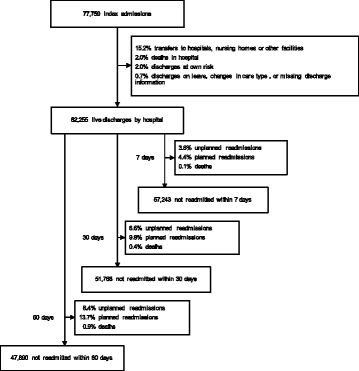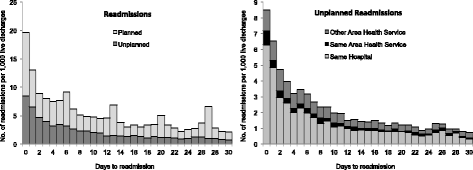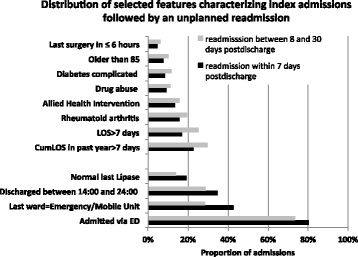Predicting 7-day, 30-day and 60-day all-cause unplanned readmission: a case study of a Sydney hospital
- PMID: 29301576
- PMCID: PMC5755362
- DOI: 10.1186/s12911-017-0580-8
Predicting 7-day, 30-day and 60-day all-cause unplanned readmission: a case study of a Sydney hospital
Abstract
Background: The identification of patients at high risk of unplanned readmission is an important component of discharge planning strategies aimed at preventing unwanted returns to hospital. The aim of this study was to investigate the factors associated with unplanned readmission in a Sydney hospital. We developed and compared validated readmission risk scores using routinely collected hospital data to predict 7-day, 30-day and 60-day all-cause unplanned readmission.
Methods: A combination of gradient boosted tree algorithms for variable selection and logistic regression models was used to build and validate readmission risk scores using medical records from 62,235 live discharges from a metropolitan hospital in Sydney, Australia.
Results: The scores had good calibration and fair discriminative performance with c-statistic of 0.71 for 7-day and for 30-day readmission, and 0.74 for 60-day. Previous history of healthcare utilization, urgency of the index admission, old age, comorbidities related to cancer, psychosis, and drug-abuse, abnormal pathology results at discharge, and being unmarried and a public patient were found to be important predictors in all models. Unplanned readmissions beyond 7 days were more strongly associated with longer hospital stays and older patients with higher number of comorbidities and higher use of acute care in the past year.
Conclusions: This study demonstrates similar predictors and performance to previous risk scores of 30-day unplanned readmission. Shorter-term readmissions may have different causal pathways than 30-day readmission, and may, therefore, require different screening tools and interventions. This study also re-iterates the need to include more informative data elements to ensure the appropriateness of these risk scores in clinical practice.
Keywords: Hospital readmission; Readmission risk scores.
Conflict of interest statement
Ethics approval and consent to participate
Ethics approval was obtained from New South Wales Population and Health Services Research Ethics Committee and the hospital’s Ethics Committee (HREC/13/CIPHS/29). The need for consent from the participants was waived by the ethics committee due to the retrospective nature of the analysis.
Consent for publication
Not applicable.
Competing interests
The authors declare that they have no competing interests.
Publisher’s Note
Springer Nature remains neutral with regard to jurisdictional claims in published maps and institutional affiliations.
Figures



References
-
- Refining the hospital readmissions reduction program. Report to the Congress: Medicare and the Health Care Delivery System. ch. 2013;4:91–114. Medicare Payment Advisory Commission. Washington, D.C., United States of America. http://www.medpac.gov/docs/default-source/reports/jun13_ch04.pdf.
-
- Spotlight on measurement: return to acute care following hospitalisation. Spotlight on readmissions. Sydney, NSW: BHI. July 2009 – June 2012.
Publication types
MeSH terms
LinkOut - more resources
Full Text Sources
Other Literature Sources
Miscellaneous

